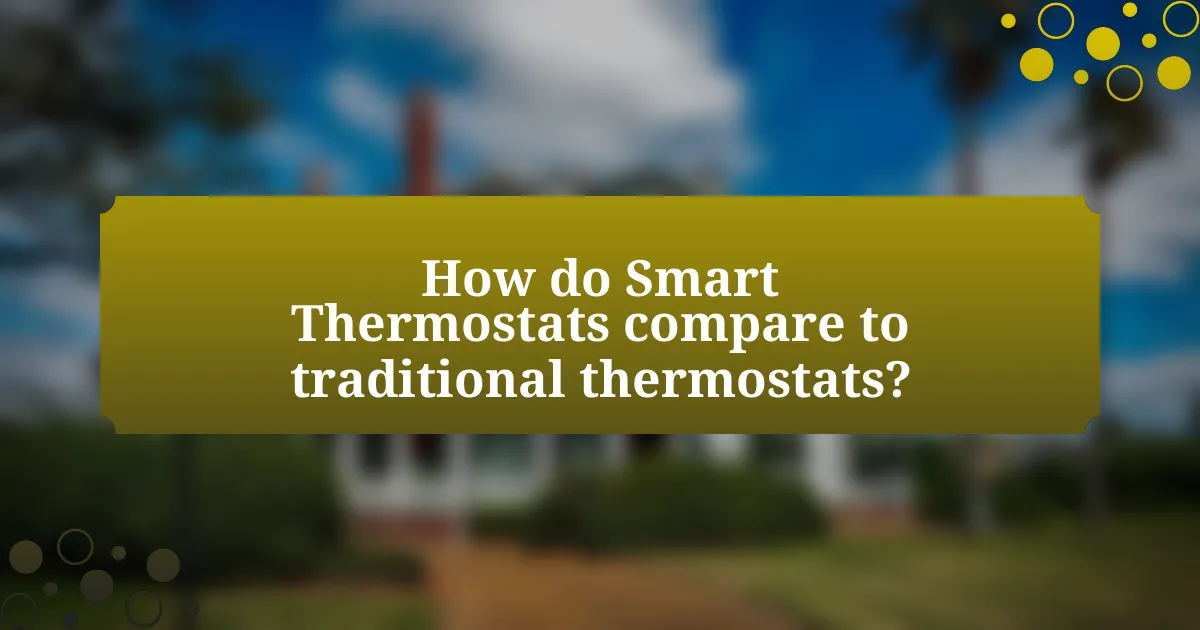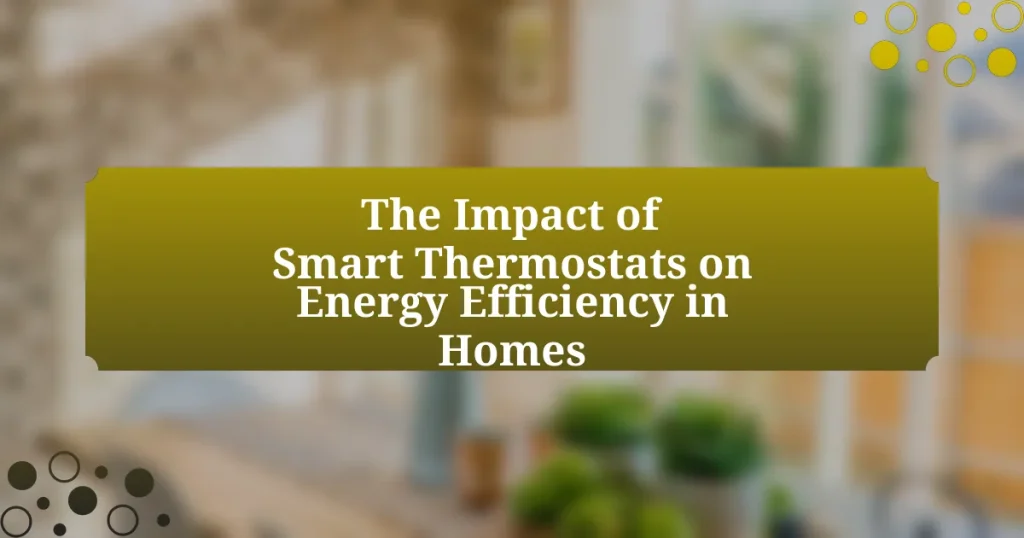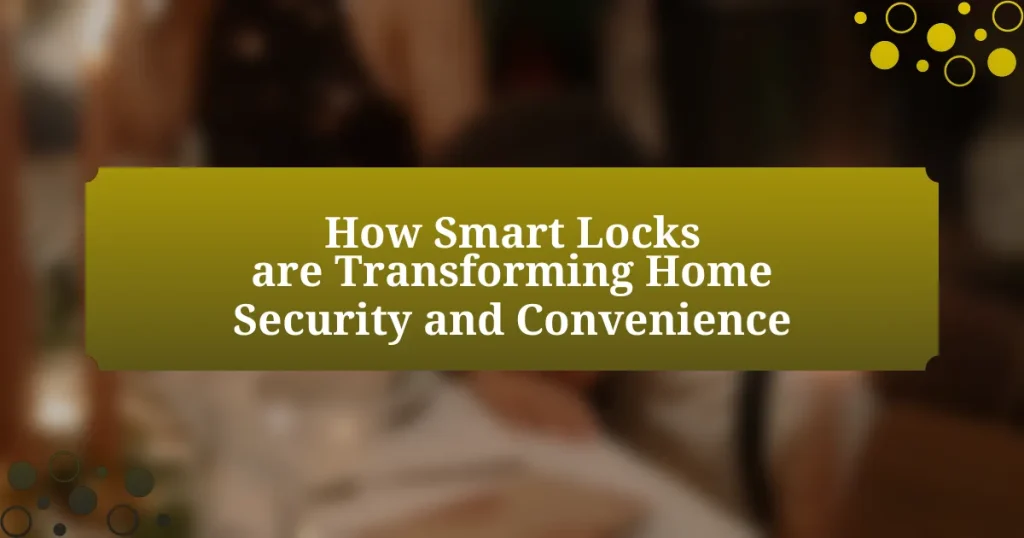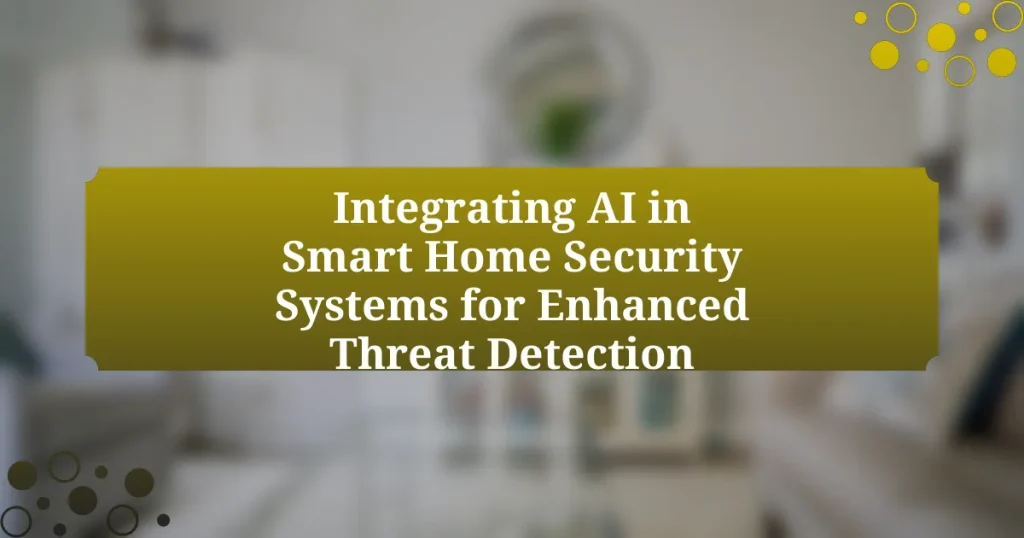Smart thermostats are advanced devices designed to enhance energy efficiency in homes by automating and optimizing heating and cooling systems. They utilize algorithms and sensors to learn user preferences, enabling significant energy savings of 10-15% on heating and cooling bills. The article explores how smart thermostats function, the technologies they integrate, their benefits in terms of cost savings and environmental impact, and how they compare to traditional thermostats. Additionally, it addresses challenges in implementation, technical issues users may face, and best practices for maximizing energy efficiency.

What are Smart Thermostats and Their Role in Energy Efficiency?
Smart thermostats are advanced devices that automate and optimize heating and cooling systems in homes, contributing significantly to energy efficiency. They utilize algorithms and sensors to learn user preferences and adjust temperatures accordingly, which can lead to energy savings of up to 10-15% on heating and cooling bills, as reported by the U.S. Department of Energy. By enabling remote access and control through smartphones, smart thermostats allow users to manage their energy consumption more effectively, reducing waste and enhancing overall efficiency in residential energy use.
How do Smart Thermostats function to optimize energy use?
Smart thermostats optimize energy use by learning user preferences and adjusting heating and cooling schedules accordingly. They utilize sensors and algorithms to monitor occupancy and temperature patterns, allowing them to automatically adjust settings when the home is unoccupied or when occupants are asleep. For instance, studies show that smart thermostats can reduce energy consumption by up to 10-15% annually by implementing features such as geofencing, which adjusts the temperature based on the homeowner’s location, and adaptive learning, which fine-tunes settings over time based on user behavior.
What technologies are integrated into Smart Thermostats?
Smart thermostats integrate several key technologies, including Wi-Fi connectivity, machine learning algorithms, and sensors. Wi-Fi connectivity allows users to control their thermostats remotely via smartphone apps, enhancing convenience and accessibility. Machine learning algorithms enable the thermostat to learn user preferences and optimize heating and cooling schedules, leading to improved energy efficiency. Additionally, sensors monitor temperature, humidity, and occupancy, allowing the thermostat to make real-time adjustments based on environmental conditions and user presence, further contributing to energy savings.
How do Smart Thermostats learn user preferences?
Smart thermostats learn user preferences through algorithms that analyze user behavior and environmental data. These devices track patterns such as temperature settings, time of day, and occupancy, allowing them to create personalized heating and cooling schedules. For instance, a study by the Lawrence Berkeley National Laboratory found that smart thermostats can reduce energy consumption by up to 10-15% by optimizing settings based on user habits. This data-driven approach enables smart thermostats to adapt over time, improving energy efficiency in homes while enhancing user comfort.
What are the key benefits of using Smart Thermostats in homes?
Smart thermostats provide significant benefits in homes, primarily through enhanced energy efficiency and cost savings. These devices optimize heating and cooling schedules based on user behavior and preferences, leading to reduced energy consumption. According to a study by the U.S. Department of Energy, homeowners can save an average of 10-15% on heating and cooling costs by using a smart thermostat. Additionally, smart thermostats offer remote access via smartphone apps, allowing users to adjust settings from anywhere, further contributing to energy savings. They also provide insights into energy usage patterns, enabling homeowners to make informed decisions about their energy consumption.
How do Smart Thermostats contribute to cost savings on energy bills?
Smart thermostats contribute to cost savings on energy bills by optimizing heating and cooling schedules based on user behavior and preferences. These devices utilize algorithms and sensors to learn when a home is occupied and adjust temperatures accordingly, reducing energy consumption during unoccupied periods. Research from the American Council for an Energy-Efficient Economy indicates that smart thermostats can save homeowners an average of 10-12% on heating and cooling costs annually. This translates to approximately $100 to $200 in savings per year, depending on the home’s energy usage patterns.
What environmental impacts do Smart Thermostats help mitigate?
Smart thermostats help mitigate environmental impacts by reducing energy consumption and greenhouse gas emissions associated with heating and cooling systems. By optimizing temperature settings based on user behavior and preferences, these devices can decrease energy usage by up to 10-15%, leading to lower demand on power plants and a reduction in fossil fuel consumption. This reduction in energy use directly correlates with decreased carbon dioxide emissions, contributing to improved air quality and a smaller carbon footprint for households.

How do Smart Thermostats compare to traditional thermostats?
Smart thermostats offer advanced features and energy-saving capabilities that traditional thermostats lack. Unlike traditional thermostats, which require manual adjustments, smart thermostats can learn user preferences, adjust settings automatically, and be controlled remotely via smartphone apps. According to a study by the American Council for an Energy-Efficient Economy, homes with smart thermostats can save an average of 10-15% on heating and cooling costs annually, demonstrating their effectiveness in enhancing energy efficiency compared to traditional models.
What are the main differences in functionality?
Smart thermostats primarily differ from traditional thermostats in their ability to learn user behavior, provide remote access, and integrate with other smart home devices. Traditional thermostats typically offer basic temperature control without adaptive features, while smart thermostats utilize algorithms to optimize heating and cooling schedules based on user habits, leading to increased energy efficiency. For instance, a study by the American Council for an Energy-Efficient Economy found that smart thermostats can reduce energy consumption by up to 10-15% compared to conventional models, demonstrating their enhanced functionality in managing energy use effectively.
How does user interaction differ between Smart and traditional thermostats?
User interaction with smart thermostats is more dynamic and user-friendly compared to traditional thermostats. Smart thermostats typically feature touchscreens, mobile app connectivity, and voice control, allowing users to adjust settings remotely and receive energy usage reports. In contrast, traditional thermostats often rely on manual adjustments through physical dials or buttons, limiting user engagement and convenience. Research indicates that smart thermostats can lead to energy savings of 10-15% due to their ability to learn user preferences and optimize heating and cooling schedules, which traditional models cannot do.
What energy savings can be expected when switching to a Smart Thermostat?
Switching to a Smart Thermostat can lead to energy savings of approximately 10% to 15% on heating and cooling bills. This reduction is primarily due to the thermostat’s ability to learn user preferences and adjust temperatures accordingly, optimizing energy use. Research conducted by the American Council for an Energy-Efficient Economy (ACEEE) indicates that households using smart thermostats can save an average of $180 annually on energy costs.
Why are Smart Thermostats becoming increasingly popular?
Smart thermostats are becoming increasingly popular due to their ability to enhance energy efficiency and provide convenience for homeowners. These devices utilize advanced algorithms and machine learning to optimize heating and cooling schedules based on user behavior and preferences, leading to significant energy savings. According to a study by the U.S. Department of Energy, homeowners can save an average of 10-15% on heating and cooling costs by using smart thermostats. Additionally, features such as remote access via smartphone apps and integration with other smart home devices further contribute to their appeal, making it easier for users to manage their home environment efficiently.
What trends in home automation are driving Smart Thermostat adoption?
The trends in home automation driving Smart Thermostat adoption include increased consumer demand for energy efficiency, integration with smart home ecosystems, and advancements in machine learning technology. Consumers are increasingly prioritizing energy-saving solutions, as evidenced by a report from the U.S. Department of Energy indicating that smart thermostats can reduce heating and cooling costs by up to 10-15%. Additionally, the rise of interconnected devices in smart homes allows for seamless integration of smart thermostats with other systems, enhancing user experience and functionality. Furthermore, machine learning capabilities enable these thermostats to learn user preferences and optimize energy usage, making them more appealing to tech-savvy homeowners.
How do consumer preferences influence the market for Smart Thermostats?
Consumer preferences significantly influence the market for smart thermostats by driving demand for features that enhance convenience, energy savings, and integration with smart home systems. As consumers increasingly prioritize energy efficiency and cost savings, manufacturers respond by developing smart thermostats that offer advanced functionalities, such as learning algorithms and remote access via mobile apps. According to a study by the American Council for an Energy-Efficient Economy, homes equipped with smart thermostats can reduce energy consumption by up to 10-15%, aligning with consumer desires for lower utility bills and environmental sustainability. This shift in consumer behavior has led to a growing market, with sales of smart thermostats increasing by over 30% annually, reflecting the direct impact of consumer preferences on product offerings and market dynamics.

What challenges and considerations exist with Smart Thermostat implementation?
Smart thermostat implementation faces several challenges and considerations, including compatibility with existing HVAC systems, user adoption, and data privacy concerns. Compatibility issues arise when older systems lack the necessary infrastructure to support smart technology, potentially requiring costly upgrades. User adoption is critical, as many individuals may struggle with the technology or resist change, impacting overall effectiveness. Data privacy concerns are significant, as smart thermostats collect personal usage data, raising questions about how this information is stored and used. These challenges must be addressed to maximize the benefits of smart thermostats in enhancing energy efficiency in homes.
What are common technical issues users face with Smart Thermostats?
Common technical issues users face with smart thermostats include connectivity problems, inaccurate temperature readings, and software glitches. Connectivity issues often arise due to weak Wi-Fi signals, which can prevent the thermostat from communicating with the home network or mobile app. Inaccurate temperature readings can occur due to sensor malfunctions or improper installation, leading to inefficient heating or cooling. Software glitches may result in unresponsive interfaces or failure to execute scheduled settings, impacting user experience and energy management. These issues can hinder the effectiveness of smart thermostats in optimizing energy efficiency in homes.
How can users troubleshoot connectivity problems?
Users can troubleshoot connectivity problems by systematically checking their network settings and devices. First, they should ensure that their smart thermostat is connected to the correct Wi-Fi network and that the network is functioning properly. This can be verified by testing the connection with other devices. Additionally, users should restart both the thermostat and the router to refresh the connection. If issues persist, checking for firmware updates on the thermostat and ensuring that the device is within range of the router can help resolve connectivity issues. According to a study by the American Council for an Energy-Efficient Economy, proper connectivity is essential for maximizing the energy-saving features of smart thermostats, highlighting the importance of resolving these issues for optimal performance.
What steps can be taken to ensure optimal performance?
To ensure optimal performance of smart thermostats in enhancing energy efficiency in homes, users should regularly update the thermostat’s software and firmware. Keeping the software current allows the device to utilize the latest features and improvements, which can enhance its efficiency and functionality. Additionally, users should calibrate the thermostat settings according to their specific heating and cooling needs, as this customization can lead to significant energy savings. Research indicates that properly programmed smart thermostats can reduce energy consumption by up to 10-15% annually, demonstrating the importance of these steps in achieving optimal performance.
What factors should homeowners consider before purchasing a Smart Thermostat?
Homeowners should consider compatibility with existing HVAC systems before purchasing a Smart Thermostat. Ensuring that the thermostat can integrate with the current heating and cooling systems is crucial for optimal performance. Additionally, homeowners should evaluate features such as remote access, learning capabilities, and energy usage reports, as these can enhance convenience and energy efficiency. According to the U.S. Department of Energy, smart thermostats can save homeowners an average of 10-15% on heating and cooling costs, reinforcing the importance of selecting a model that aligns with individual needs and preferences.
How do different models vary in features and pricing?
Different smart thermostat models vary significantly in features and pricing, with basic models starting around $100 and advanced models exceeding $300. Basic models typically offer essential functions such as temperature control and scheduling, while advanced models include features like Wi-Fi connectivity, learning algorithms, energy usage reports, and integration with smart home systems. For example, the Nest Learning Thermostat, priced around $250, learns user preferences and optimizes energy usage, whereas a simpler model like the Honeywell RTH9585WF, priced around $200, provides programmable settings but lacks advanced learning capabilities. This price and feature differentiation allows consumers to choose a model that best fits their energy efficiency goals and budget.
What compatibility issues might arise with existing HVAC systems?
Compatibility issues with existing HVAC systems may arise when integrating smart thermostats, primarily due to differences in communication protocols and voltage requirements. Many older HVAC systems utilize 24V systems, while some smart thermostats may require a C-wire for continuous power, which older systems might not have. Additionally, proprietary communication protocols used by certain HVAC manufacturers can prevent smart thermostats from effectively interfacing with the system, leading to functionality limitations. For instance, a study by the American Council for an Energy-Efficient Economy highlights that compatibility challenges can hinder the expected energy savings from smart thermostat installations, emphasizing the importance of ensuring system compatibility before implementation.
What are best practices for maximizing energy efficiency with Smart Thermostats?
To maximize energy efficiency with smart thermostats, users should program the thermostat to align with their daily schedules and preferences. This involves setting temperature adjustments for when the home is unoccupied, typically lowering heating or cooling during these periods, which can reduce energy consumption by up to 10-15% according to the U.S. Department of Energy. Additionally, utilizing features such as geofencing allows the thermostat to adjust temperatures based on the homeowner’s location, ensuring energy is not wasted when no one is home. Regularly updating the thermostat’s software and maintaining the HVAC system also contribute to optimal performance and efficiency.
How can users effectively set schedules and preferences?
Users can effectively set schedules and preferences by utilizing the programming features of smart thermostats, which allow for customized temperature settings based on daily routines. By inputting specific times for heating or cooling, users can optimize energy usage, ensuring that systems operate only when needed. Research indicates that homes with programmed smart thermostats can save up to 10-15% on heating and cooling costs, demonstrating the financial benefits of effective scheduling.
What tips can enhance the energy-saving capabilities of Smart Thermostats?
To enhance the energy-saving capabilities of smart thermostats, users should utilize features such as scheduling, geofencing, and learning algorithms. Scheduling allows users to set specific temperatures for different times of the day, reducing energy use when the home is unoccupied. Geofencing uses the location of the homeowner’s smartphone to adjust the temperature based on whether they are home or away, optimizing energy consumption. Learning algorithms enable the thermostat to adapt to the homeowner’s habits over time, further improving efficiency by anticipating heating and cooling needs. According to the U.S. Department of Energy, using a programmable thermostat can save about 10% to 30% on heating and cooling costs annually.














